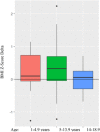Excess weight gain in the paediatric bleeding disorders population: Impact of the COVID-19 Pandemic
- PMID: 34761485
- PMCID: PMC8653224
- DOI: 10.1111/hae.14449
Excess weight gain in the paediatric bleeding disorders population: Impact of the COVID-19 Pandemic
Abstract
Introduction: The COVID-19 pandemic has resulted in lifestyle changes for children. The aim of this study was to evaluate the impact of the pandemic on weight/BMI in children with severe bleeding disorders.
Methods: We conducted a retrospective review of patients age 3-18 years with severe bleeding disorders on prophylactic therapy treated at SickKids Hospital (Toronto, Canada) between February 01, 2018 and March 31, 2021. We evaluated the following pre- and post-COVID variables: weight (kg), weight percentile, BMI (kg/m2 ), BMI percentile, HJHS score, and prophylactic dosing (units/kg).
Results: One hundred and four patients were included in the final analysis. Diagnoses were as follows: haemophilia A (n = 92; 70.8%), haemophilia B (n = 17; 13.1%), type 3 von Willebrand disease (n = 11; 8.5%), the remainder were diagnosed with rare factor deficiencies. Median interval time from pre-COVID measurements to latest follow-up was 12.4 months (IQR 10.32-14.52 months) during which there was a statistically significant increase in median weight percentile +5.75 centiles (from 63rd centile to 68.75th centile). There was a statistically significant increase in mean BMI of +1.03 kg/m2 (P = < .001) while median BMI percentile increased +8.82 centiles (from 53.9th centile to 62.72nd centile) and mean BMI percentile increased 3.42 centiles (from 57.5 centile to 60.9 centile). The group that gained the most weight centiles, BMI and BMI centiles were 5-14 years old.
Conclusion: There was a trend to weight gain over the study period. More long-term data is required to evaluate the impact of this increase in weight and BMI on children with bleeding disorders.
Keywords: BMI; COVID-19; haemophilia; severe bleeding disorder; weight gain.
© 2021 John Wiley & Sons Ltd.
Figures
References
-
- Banis S, Suurmeijer ThPBM, Van Peer DR. Child‐rearing practices toward children with hemophilia: the relative importance of clinical characteristics and parental emotional reactions. Family Relations. 1999;48(2):207.
-
- Canadian Consumers Prepare for COVID‐19 . (2020). Canadian Consumers Prepare for COVID‐19. https://www150.statcan.gc.ca/n1/pub/62f0014m/62f0014m2020004‐eng.htm
MeSH terms
LinkOut - more resources
Full Text Sources
Medical
Miscellaneous





